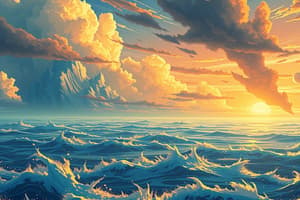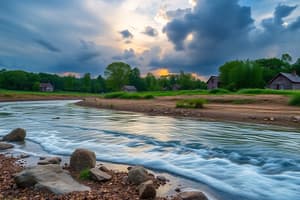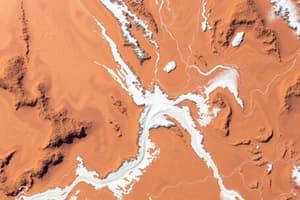Podcast
Questions and Answers
Which of the following factors would have the net effect of making a place warmer in the summer?
Which of the following factors would have the net effect of making a place warmer in the summer?
- In the middle of a landmass (correct)
- At a high latitude
- At a high elevation
- Near an ocean
Cloud cover reduces both the daily high and daily low temperatures.
Cloud cover reduces both the daily high and daily low temperatures.
False (B)
Summer temperatures along the California coast are cooler than along the coast of South Carolina, due to the influence of:
Summer temperatures along the California coast are cooler than along the coast of South Carolina, due to the influence of:
- Specific heat
- Altitude
- Ocean currents (correct)
- Evaporation
- Latitude
A primary reason for drawing isotherms on a map of temperature values is to allow:
A primary reason for drawing isotherms on a map of temperature values is to allow:
The annual temperature range at most latitudes in the southern hemisphere is much smaller than in the northern hemisphere. Why?
The annual temperature range at most latitudes in the southern hemisphere is much smaller than in the northern hemisphere. Why?
During a typical day, the lowest temperature usually occurs about midnight.
During a typical day, the lowest temperature usually occurs about midnight.
A location on a windward coast refers to a place where the prevailing wind is:
A location on a windward coast refers to a place where the prevailing wind is:
The annual temperature range is quite small near the equator. This is true primarily because:
The annual temperature range is quite small near the equator. This is true primarily because:
A poleward moving (northward moving in the Northern Hemisphere) ocean current is:
A poleward moving (northward moving in the Northern Hemisphere) ocean current is:
Which of the following associations is CORRECT?
Which of the following associations is CORRECT?
How is the annual mean temperature calculated?
How is the annual mean temperature calculated?
The annual temperature range at most latitudes in the Southern Hemisphere is much smaller than that in the Northern Hemisphere. The reason for this is that:
The annual temperature range at most latitudes in the Southern Hemisphere is much smaller than that in the Northern Hemisphere. The reason for this is that:
The melting point of ice is 32°C.
The melting point of ice is 32°C.
The most important cause of temperature variations is:
The most important cause of temperature variations is:
Surface air temperatures rise and fall more slowly over land areas.
Surface air temperatures rise and fall more slowly over land areas.
The warmest temperature ever recorded in the United States occurred in Death Valley, CA.
The warmest temperature ever recorded in the United States occurred in Death Valley, CA.
Overnight temperatures are warmer when the air is humid because:
Overnight temperatures are warmer when the air is humid because:
An isotherm on a map:
An isotherm on a map:
Locations that have the same Sun angle always have very similar temperatures.
Locations that have the same Sun angle always have very similar temperatures.
Which type of lifting mechanism results from warm air lifting over cold air?
Which type of lifting mechanism results from warm air lifting over cold air?
Sinking or subsiding air cannot form clouds due to the:
Sinking or subsiding air cannot form clouds due to the:
In which phase do water molecules have the lowest kinetic energy?
In which phase do water molecules have the lowest kinetic energy?
The temperature of rising air parcels ________ as they move upward.
The temperature of rising air parcels ________ as they move upward.
A stable atmosphere is one in which:
A stable atmosphere is one in which:
The attractive forces between the hydrogen atoms in one water molecule and the oxygen atoms in another molecule are known as:
The attractive forces between the hydrogen atoms in one water molecule and the oxygen atoms in another molecule are known as:
The most important process of cloud formation in the atmosphere is:
The most important process of cloud formation in the atmosphere is:
These two conditions, working together, will make the atmosphere the most unstable.
These two conditions, working together, will make the atmosphere the most unstable.
The capacity of the air to hold water vapor:
The capacity of the air to hold water vapor:
All of the following are lifting mechanisms in the atmosphere EXCEPT:
All of the following are lifting mechanisms in the atmosphere EXCEPT:
What is the primary difference between concepts of weather and climate?
What is the primary difference between concepts of weather and climate?
Studies have shown that the average ozone depletion is greatest over which area?
Studies have shown that the average ozone depletion is greatest over which area?
Water vapor represents what fraction of the air near the Earth's surface?
Water vapor represents what fraction of the air near the Earth's surface?
Scientific hypotheses are rejected when they do not agree with observed data.
Scientific hypotheses are rejected when they do not agree with observed data.
While ascending through the atmosphere, which region are you most likely in if the temperature rises from -48°C to -18°C over the last 10 km?
While ascending through the atmosphere, which region are you most likely in if the temperature rises from -48°C to -18°C over the last 10 km?
With an increase in altitude, air pressure:
With an increase in altitude, air pressure:
The 'weather sphere' is in the:
The 'weather sphere' is in the:
Which of the following outlines the steps of the scientific method in the correct order?
Which of the following outlines the steps of the scientific method in the correct order?
This atmospheric component absorbs damaging ultraviolet radiation from the Sun.
This atmospheric component absorbs damaging ultraviolet radiation from the Sun.
Which of the following is the MOST important atmospheric component with regard to the Earth's climate and the formation of weather systems?
Which of the following is the MOST important atmospheric component with regard to the Earth's climate and the formation of weather systems?
Weather and climate are synonymous terms.
Weather and climate are synonymous terms.
The four thermal layers of the atmosphere in order beginning from the surface are:
The four thermal layers of the atmosphere in order beginning from the surface are:
Ninety percent of our atmosphere lies below an altitude of about:
Ninety percent of our atmosphere lies below an altitude of about:
Weather influences people, but people don't influence weather.
Weather influences people, but people don't influence weather.
The ozone layer is found in the:
The ozone layer is found in the:
Which two gases make up a combined total of 99% of clean, dry air in the homosphere?
Which two gases make up a combined total of 99% of clean, dry air in the homosphere?
The basic elements of weather and climate include all of the following, except:
The basic elements of weather and climate include all of the following, except:
Which one of the following is the MOST abundant gas in the atmosphere?
Which one of the following is the MOST abundant gas in the atmosphere?
The term meteorology:
The term meteorology:
A scientific hypothesis may be regarded as a tentative explanation of observed facts or events.
A scientific hypothesis may be regarded as a tentative explanation of observed facts or events.
Ozone:
Ozone:
The summit of Mt. Everest (8.85 km) is found in the:
The summit of Mt. Everest (8.85 km) is found in the:
Ozone is concentrated in the:
Ozone is concentrated in the:
Which of the following statements is an expression of climate?
Which of the following statements is an expression of climate?
What best explains the 'bumps' seen in the CO2 concentrations on the graph?
What best explains the 'bumps' seen in the CO2 concentrations on the graph?
According to current scientific theory, what is the likely reason for the upward trend in overall CO2 concentrations?
According to current scientific theory, what is the likely reason for the upward trend in overall CO2 concentrations?
Atmospheric pressure is caused by:
Atmospheric pressure is caused by:
On average, for every 1 km increase in altitude in the troposphere, the air temperature:
On average, for every 1 km increase in altitude in the troposphere, the air temperature:
Assuming the average value of the environmental lapse rate, what would be the temperature in the troposphere at a height of 3 km if the temperature at the surface is 20°C?
Assuming the average value of the environmental lapse rate, what would be the temperature in the troposphere at a height of 3 km if the temperature at the surface is 20°C?
In the process of scientific inquiry, a theory is best defined as:
In the process of scientific inquiry, a theory is best defined as:
During natural processes, heat transfer is always from:
During natural processes, heat transfer is always from:
Heat:
Heat:
Fairbanks, Alaska (65°N), has more hours of daylight in June than Miami, Florida (26°N).
Fairbanks, Alaska (65°N), has more hours of daylight in June than Miami, Florida (26°N).
Over the course of this year, the tilt of Earth's polar axis will:
Over the course of this year, the tilt of Earth's polar axis will:
The Earth receives energy from the Sun by:
The Earth receives energy from the Sun by:
Which of the following does NOT happen to solar radiation as it passes through the atmosphere?
Which of the following does NOT happen to solar radiation as it passes through the atmosphere?
Low sun angles result in reduced solar energy because:
Low sun angles result in reduced solar energy because:
Most of the solar energy absorbed by planet Earth and its atmosphere is absorbed by:
Most of the solar energy absorbed by planet Earth and its atmosphere is absorbed by:
The absorption of longwave radiation by certain gases in the lower atmosphere is responsible for:
The absorption of longwave radiation by certain gases in the lower atmosphere is responsible for:
The spring equinox in the Northern Hemisphere occurs on approximately:
The spring equinox in the Northern Hemisphere occurs on approximately:
Pure white sunlight contains all of the colors of the visible light spectrum.
Pure white sunlight contains all of the colors of the visible light spectrum.
The length of daylight gets progressively longer going south from the equator on:
The length of daylight gets progressively longer going south from the equator on:
Deserts, with their very dry air, experience cool nighttime temperatures because of a weaker greenhouse effect.
Deserts, with their very dry air, experience cool nighttime temperatures because of a weaker greenhouse effect.
The longest day of the year in the United States occurs on:
The longest day of the year in the United States occurs on:
Snow-covered surfaces have a low albedo.
Snow-covered surfaces have a low albedo.
The primary cause of Earth's seasons is:
The primary cause of Earth's seasons is:
The process of ________ involves the movement or circulation of a mass or substance.
The process of ________ involves the movement or circulation of a mass or substance.
Of the following choices, the surface with the HIGHEST albedo is:
Of the following choices, the surface with the HIGHEST albedo is:
The primary factor which determines what type and how much radiation an object emits is its:
The primary factor which determines what type and how much radiation an object emits is its:
Which of the following correctly describes the equinoxes?
Which of the following correctly describes the equinoxes?
The atmosphere is highly ________ with respect to solar radiation.
The atmosphere is highly ________ with respect to solar radiation.
Seasonal temperature variations are due primarily to the changing distance between the Earth and the Sun.
Seasonal temperature variations are due primarily to the changing distance between the Earth and the Sun.
Clouds are most likely to ________ incoming solar radiation.
Clouds are most likely to ________ incoming solar radiation.
Which of the following gases is the best absorber of ultraviolet light?
Which of the following gases is the best absorber of ultraviolet light?
What would happen on Earth if the Sun were 'turned off' and ceased to provide heat?
What would happen on Earth if the Sun were 'turned off' and ceased to provide heat?
Most of the radiation emitted by the Earth and its atmosphere is in the category of:
Most of the radiation emitted by the Earth and its atmosphere is in the category of:
The 90-degree angle rays strike the Tropic of Cancer on:
The 90-degree angle rays strike the Tropic of Cancer on:
Which of the following gases does not absorb any portion of incoming solar radiation?
Which of the following gases does not absorb any portion of incoming solar radiation?
At 45 degrees S latitude, the angle of the noon Sun is lowest and the length of daylight is shortest on:
At 45 degrees S latitude, the angle of the noon Sun is lowest and the length of daylight is shortest on:
The wavelengths emitted by the Earth are:
The wavelengths emitted by the Earth are:
The primary purpose served by surface ocean currents is to:
The primary purpose served by surface ocean currents is to:
Isotherm lines do not always pass directly through observing station locations.
Isotherm lines do not always pass directly through observing station locations.
Surface air temperatures rise and fall more slowly over land areas.
Surface air temperatures rise and fall more slowly over land areas.
Comfortable room temperature is roughly 22°C.
Comfortable room temperature is roughly 22°C.
Which of these factors influences the sensation of temperature that the human body feels?
Which of these factors influences the sensation of temperature that the human body feels?
What type of severe weather event killed up to 35,000 people in Europe during the summer of 2003?
What type of severe weather event killed up to 35,000 people in Europe during the summer of 2003?
How is the daily maximum temperature affected by the presence of clouds?
How is the daily maximum temperature affected by the presence of clouds?
Locations on Earth which have the largest annual temperature change from summer to winter are often:
Locations on Earth which have the largest annual temperature change from summer to winter are often:
Consider the isotherm map of the United States shown above. Which of the following is the best realistic estimate of the current temperature at the spot marked by an X?
Consider the isotherm map of the United States shown above. Which of the following is the best realistic estimate of the current temperature at the spot marked by an X?
Which of these factors influences the sensation of temperature that the human body feels?
Which of these factors influences the sensation of temperature that the human body feels?
A place located along a windward coast:
A place located along a windward coast:
Flashcards
Weather
Weather
Short-term atmospheric conditions like temperature and precipitation.
Climate
Climate
Long-term weather patterns averaged over time.
Ozone Layer
Ozone Layer
Layer in the stratosphere that absorbs harmful UV radiation.
Atmospheric Pressure
Atmospheric Pressure
Signup and view all the flashcards
Scientific Method
Scientific Method
Signup and view all the flashcards
Hypothesis
Hypothesis
Signup and view all the flashcards
Temperature Gradient
Temperature Gradient
Signup and view all the flashcards
Greenhouse Effect
Greenhouse Effect
Signup and view all the flashcards
Isotherms
Isotherms
Signup and view all the flashcards
Air Parcel
Air Parcel
Signup and view all the flashcards
Cloud Formation
Cloud Formation
Signup and view all the flashcards
Kinetic Energy in Water States
Kinetic Energy in Water States
Signup and view all the flashcards
Stable Atmosphere
Stable Atmosphere
Signup and view all the flashcards
Frontal Wedging
Frontal Wedging
Signup and view all the flashcards
Humidity
Humidity
Signup and view all the flashcards
Ocean Currents
Ocean Currents
Signup and view all the flashcards
Axial Tilt
Axial Tilt
Signup and view all the flashcards
Temperature Stability
Temperature Stability
Signup and view all the flashcards
Temperature Range
Temperature Range
Signup and view all the flashcards
Orographic Lifting
Orographic Lifting
Signup and view all the flashcards
Atmospheric Lifting Mechanisms
Atmospheric Lifting Mechanisms
Signup and view all the flashcards
Temperature Dynamics
Temperature Dynamics
Signup and view all the flashcards
Solar Radiation
Solar Radiation
Signup and view all the flashcards
Temperature Sensation
Temperature Sensation
Signup and view all the flashcards
Water Vapor Capacity
Water Vapor Capacity
Signup and view all the flashcards
Instability in Atmosphere
Instability in Atmosphere
Signup and view all the flashcards
Troposphere
Troposphere
Signup and view all the flashcards
Stratosphere
Stratosphere
Signup and view all the flashcards
Heat Transfer
Heat Transfer
Signup and view all the flashcards
Antarctic Ozone Depletion
Antarctic Ozone Depletion
Signup and view all the flashcards
Evaporation and Cooling
Evaporation and Cooling
Signup and view all the flashcards
Study Notes
Weather and Climate Foundations
- Weather refers to short-term atmospheric conditions, while climate describes long-term weather patterns over time.
- Average ozone depletion is most significant over Antarctica.
Atmospheric Composition
- Water vapor constitutes less than 4% of the air near Earth's surface.
- Ozone plays a crucial role in absorbing harmful ultraviolet radiation.
- Nitrogen and oxygen together make up 99% of clean, dry air.
Scientific Methodology
- A scientific hypothesis is rejected if it contradicts observed data.
- Steps of the scientific method: collect data, develop hypothesis, test hypothesis, accept/modify/reject hypothesis.
- A scientific theory is a hypothesis that has been extensively tested and accepted by the scientific community.
Atmospheric Layers
- The stratosphere is identified as the layer where temperature increases with altitude.
- The troposphere is known as the "weather sphere," containing most of Earth's weather activities.
- The ozone layer exists within the stratosphere.
Temperature and Pressure Dynamics
- Atmospheric pressure decreases with altitude, primarily due to the weight of the air above.
- For every 1 km increase in altitude, air temperature drops about 6.5 degrees Celsius on average.
- Ninety percent of Earth's atmosphere is located below an altitude of approximately 16 km.
Environmental Factors Influencing Weather
- Heat transfer always occurs from warmer to cooler substances.
- Clouds absorb and reflect incoming solar radiation, affecting daily temperature variations.
- Locations on windward coasts generally experience cooler summer temperatures compared to inland areas.
Climate and Seasonal Variations
- Earth's axial tilt of 23.5 degrees is the primary reason for seasonal changes.
- The greenhouse effect is caused by certain gases absorbing longwave radiation emitted by the Earth.
- During equinoxes, day and night are of equal length across the globe.
Solar Radiation Interactions
- Most solar energy is absorbed by Earth's surface while some is scattered or absorbed by atmospheric gases.
- The absorption of ultraviolet light is best done by oxygen and ozone.
- The wavelengths emitted by Earth are longer than those emitted by the Sun, with most being in the infrared category.
Ocean Currents and Temperature Patterns
- Surface ocean currents play a key role in transferring heat and balancing energy distribution between polar and equatorial regions.
- Cooler summer temperatures are often observed along coasts influenced by ocean currents compared to inland areas.
Temperature Sensation and Variation
- Human sensation of temperature is influenced by air temperature, wind speed, and humidity.
- The daily maximum temperature tends to be cooler in the presence of clouds.
- Areas at high latitudes exhibit the largest annual temperature changes from summer to winter.
Conclusively Understanding Weather Patterns
- Weather influences human activities, but humans have minimal direct impact on weather phenomena.
- Surface temperatures generally rise and fall more slowly over land compared to water bodies.### Temperature and Climatology
- Near the equator, the annual temperature range is small due to uniform solar radiation throughout the year.
- Poleward moving ocean currents in the Northern Hemisphere are warm currents.
Temperature Range and Characteristics
- High latitude areas have low annual temperature ranges; water has a high specific heat, affecting temperature stability.
- The annual mean temperature is the average of the 12 monthly mean temperatures.
- The Southern Hemisphere has a smaller annual temperature range due to a greater percentage of ocean surface compared to land.
True or False Statements
- The melting point of ice is not 32°C; it is actually 0°C.
- Surface air temperatures vary faster over land than over water.
- The highest temperature recorded in the United States was in Death Valley, CA.
Humidity and Temperature
- Warmer overnight temperatures occur with humidity because water vapor absorbs outgoing longwave radiation effectively.
Isotherms and Temperature
- Isotherms on maps connect points of equal temperature, allowing for visual representation of temperature distribution.
- Locations with the same Sun angle can have different temperatures due to various geographical and atmospheric factors.
Lifting Mechanisms
- Frontal wedging is the mechanism where warm air rises over cold air, leading to cloud formation.
- Sinking air does not form clouds due to warming temperatures associated with subsiding air.
Kinetic Energy in States of Water
- Water molecules in ice exhibit the lowest kinetic energy compared to vapor and liquid states.
Air Parcel Behavior
- As air parcels rise, their temperature decreases, impacting weather patterns and cloud formation.
Atmospheric Stability
- A stable atmosphere resists upward vertical motions; this is crucial for weather predictions.
Molecular Interactions
- Hydrogen bonds are the attractive forces between water molecules, critical for water's unique properties.
Cloud Formation
- The main process of cloud formation in the atmosphere is cooling by the expansion of air, which leads to condensation.
Instability in the Atmosphere
- The atmosphere becomes most unstable when the surface is warm and the upper air is cold, promoting vertical movement of air.
Water Vapor Capacity
- The capacity of air to hold water vapor increases with rising temperatures.
Atmospheric Lifting Mechanisms
- Atmospheric lifting mechanisms include Convection, Orographic lifting, and Frontal wedging, while Divergence is not classified as a lifting mechanism.
Studying That Suits You
Use AI to generate personalized quizzes and flashcards to suit your learning preferences.




